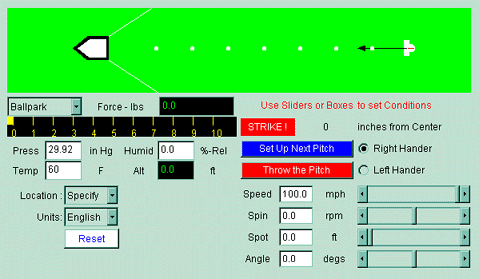
|
Did You Catch My
Drift?
|

|
Subject Area: Physical Science
Grade Level: 8-10
National Science Standards:
- Science as Inquiry:
- Understandings about scientific inquiry.
- Abilities necessary to do scientific inquiry
- Physical Science: Motions and forces.
- Science and Technology:
- Abilities of technological design.
- Understandings about science and technology.
National Technology Standards:
- Technology research tools: Use content-specific tools,
software and simulations (e.g., environmental probes, graphing
calculators, exploratory environments, Web tools) to support
learning and research; select and use appropriate tools and
technology resources to accomplish a variety of tasks and solve
problems.
- Problem-Solving and Decision-Making Tools - Routinely
and efficiently use on-line information resources to meet needs
for collaboration, research, publications, communications, and
productivity.
Objectives:
Students will, through the use of the CurveBall interactive
software package, become familiar with the way in which the flow
of air across or around an object affects its ability to lift,
spin, and curve. After reading the explanation given below,
use CurveBall
to become familiar with the concepts.
CurveBall is an interactive
simulation software package that examines the aerodynamics of throwing a
big league curve ball. As you change parameters such as speed, rotation on the ball,
release point and angle, and atmospheric conditions,
the software calculates the side force on the ball and the resulting trajectory.
The package was created at the NASA
Glenn Research Center.
CurveBall is a Java applet program that executes inside the browser of your computer.
It is available on the World Wide Web at
http://www.grc.nasa.gov/WWW/K-12/airplane/foil2b.html.
You can also
download the program to run off-line.
Shown below is a screen
shot from the program's controls and displays. You may change the values
of the variables by using the slider or the input box on the left of the
slider.
To use the slider:
- Click the mouse
pointer on the arrows at the ends of the slider.
- Click the mouse
pointer anywhere between the slider and the arrow.
- Drag the slider
with the mouse.
To use the input
box:
Simply select the
value in the input box, key in the new value, and press Enter or Tab when
finished. The button on the slider will move corresponding to the value
typed in the box.

To begin the problem, click on Did You
Catch My Drift? Activity.
Assessment:
Working alone or in pairs, write an explanation for the
advice that the catcher gave to the pitcher. Give any mathematical
and graphical evidence that supports your answer.
Evaluation:
Each student or pair of students will be able to use
CurveBall to demonstrate that the answer they gave in
writing will accomplish the task needed (strike out the batter.)
Submitted by: Lorri Turner, Monticello Middle School,
Cleveland Heights, Ohio.
|
